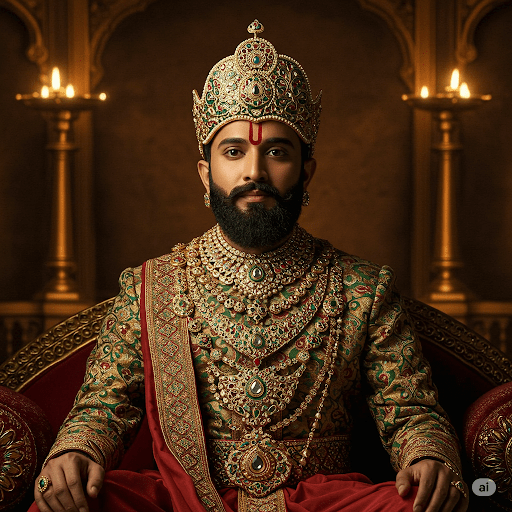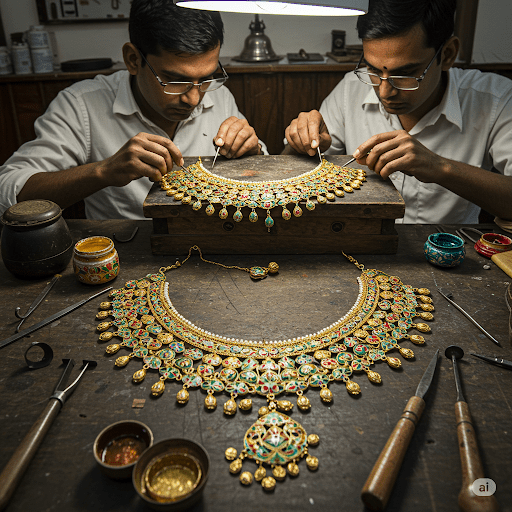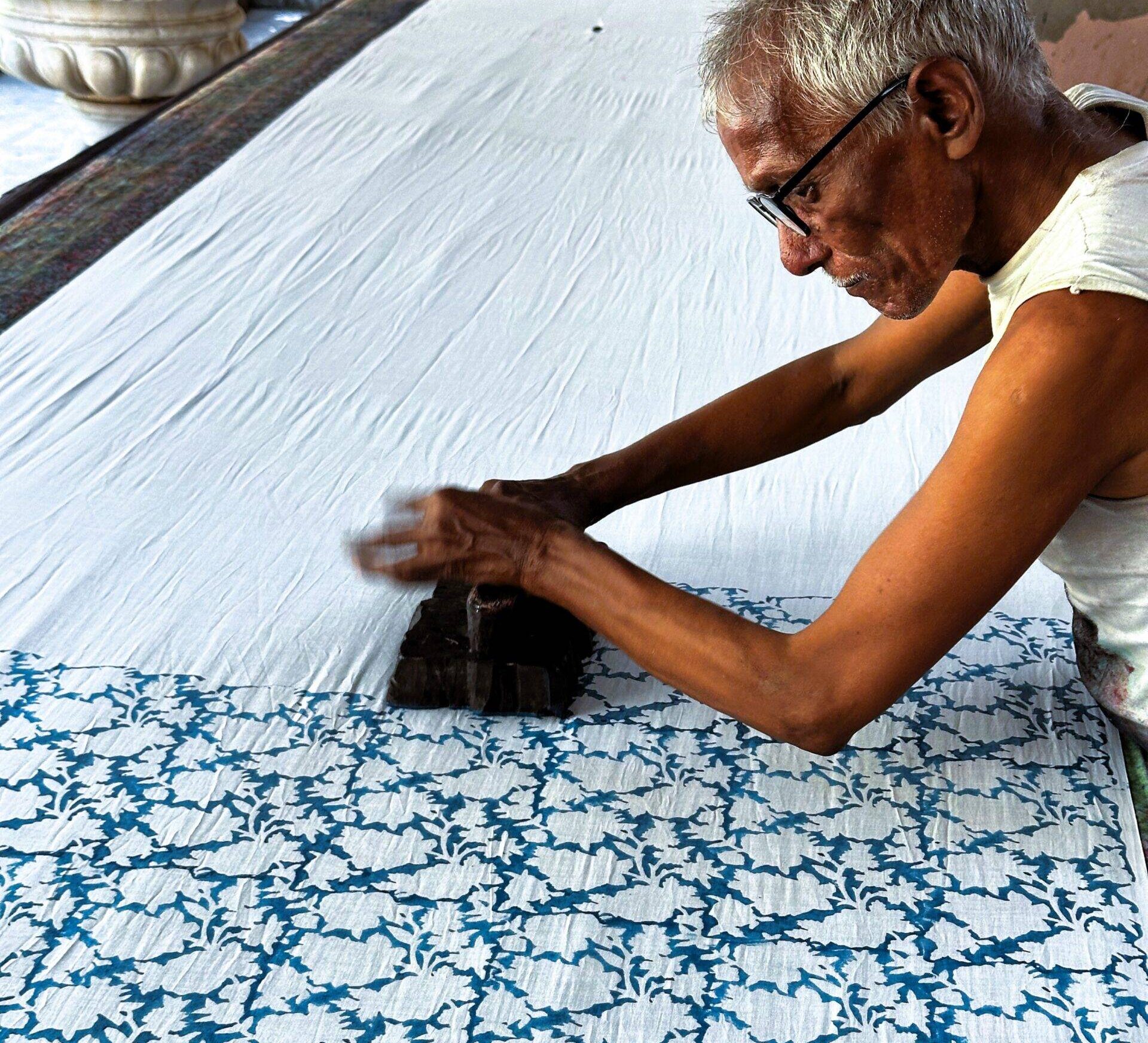Introduction
Ever laid your eyes on a piece of jewellery that feels like a tiny piece of art? That’s Meenakari for you. It’s not just an accessory – it’s tradition, craftsmanship, and heritage rolled into one. Known for its brilliant colours and intricate designs, Meenakari has stood the test of time, from royal courts to modern runways. But what makes this jewellery style so unique?
Let’s dive deep into the world of Meenakari and discover why it’s more than just sparkle—it’s a story told in enamel and gold.
The Rich History of Meenakari
Origins in Persia
Meenakari traces its roots back to ancient Persia. The word Meena comes from the Persian word for “heaven,” representing the sky’s blue. It was originally a decorative art used on metal surfaces and religious items before it became a popular jewellery style.
The Arrival of Meenakari in India
It was the Mughals who brought this stunning art form to India. Skilled craftsmen from Persia were invited to work in Indian courts, blending their techniques with Indian motifs and patterns.
Royal Patronage in the Mughal Era
Mughal emperors were fascinated by detailed craftsmanship, and Meenakari quickly found favour among the royals. It was often paired with Kundan work, leading to some of the most luxurious pieces of the time.

The Craftsmanship Behind Meenakari
The Role of the Meenakar
Creating Meenakari isn’t a one-person job. It involves Meenakars (enamellers), engravers, goldsmiths, polishers, and stone setters. Each one brings their skill to the table to craft a single masterpiece.
Step-by-Step Process of Meenakari
Designing and Engraving
First comes the design, which is hand-drawn on metal, typically gold or silver. Then, engravers carve intricate grooves for the enamel to sit in.
Applying Enamels
These grooves are filled with natural mineral-based powdered colours. Each hue requires precision, and colours are layered one by one.
Firing and Polishing
The piece is fired in a kiln at 750°C. The heat fuses the enamel to the metal. After cooling, the piece is polished to bring out that radiant glow.

Jaipur – The Heart of Meenakari in India
Why Jaipur Became the Hub
When Raja Man Singh I of Amber brought artisans to Jaipur in the 16th century, it became the centre of Meenakari art. The pink city’s vibrant culture and royal patronage helped the craft flourish.
Signature Jaipur Styles of Meenakari
Jaipur’s Meenakari is distinct because of its multi-coloured enamelling on the reverse side of Kundan jewellery. This dual design makes the pieces both beautiful and functional.
Famous Artisans and Lineages in Jaipur
Families in Jaipur have passed this craft down generations. Some artisans have been practising this art for over 300 years! Names like Bharat Bhushan, Sunil Meenakar, and others are legendary in this field.
Materials Used in Meenakari Jewellery
Base Metals: Gold, Silver, and Copper
Traditionally, gold is preferred because it holds enamel well, but silver and copper are also used for more affordable options.
Enamels and Natural Pigments
The colours in Meenakari are derived from ground minerals mixed with special oils—making them both vibrant and long-lasting.
Use of Precious and Semi-Precious Stones
Kundan, emeralds, rubies, sapphires, and pearls often adorn Meenakari jewellery, elevating its grandeur.

The Vibrant Colours of Meenakari
Symbolism of Colours
Every colour in Meenakari has meaning. Red symbolizes passion, green denotes prosperity, and blue represents the divine.
Popular Colour Combinations in Jaipur Meenakari
Jaipur artists love bold contrasts—reds with greens, blues with yellows. It’s a visual treat!
Innovation in Modern Palettes
Today’s designers are experimenting with pastels, metallics, and even neons, making Meenakari more wearable and modern.
Traditional vs Modern Meenakari
Antique Heritage Pieces
Antique Meenakari pieces are often heavier, richer in enamel, and passed down as heirlooms. They carry unmatched cultural value.
Contemporary Designs for Everyday Wear
Modern Meenakari jewellery is lightweight, minimalistic, and perfect for casual outings or office wear. You’ll find rings, earrings, and even smartwatches with Meenakari detailing!
How Meenakari Is Used Today
In Weddings and Festivals
No Indian bride’s trousseau is complete without a splash of Meenakari. It’s a staple during weddings, Diwali, Holi, and Navratri.
As Statement Fashion Accessories
From runways to red carpets, Meenakari is the go-to accessory for bold fashion statements.
Global Fashion and Bollywood Influence
Stars like Deepika Padukone and Sonam Kapoor often flaunt Meenakari pieces, giving this ancient art a global spotlight.
Preserving the Art of Meenakari
Government and NGO Initiatives
Schemes like “Hunar Haat” and “Make in India” support local artisans by offering training and selling platforms.
Efforts by Artisans to Keep it Alive
Young Meenakars are mixing tradition with technology—selling online, teaching workshops, and collaborating with international brands.
Tips to Buy Authentic Meenakari Jewellery
Identifying Real Meenakari
Look for uneven textures, natural colour tones, and hand-done detailing. Real Meenakari never looks factory-made.
Trusted Places to Shop
Jaipur’s Johari Bazaar, Delhi’s Dilli Haat, and online platforms like CraftsVilla, Jaypore, and Tjori are great places to find authentic pieces.
Caring for Meenakari Jewellery
Cleaning and Storing
Use a soft cloth to wipe your jewellery. Store in cotton-lined boxes away from moisture and direct sunlight.
Avoiding Common Mistakes
Never use harsh chemicals or ultrasonic cleaners. Don’t soak them in water. Handle with care—they’re delicate pieces of art.
Why Meenakari Jewellery Stands Out
Intricate Beauty
Each piece is handcrafted with love, skill, and patience. No two are ever the same.
Cultural Significance
It represents centuries of history, artistry, and heritage—all locked in one tiny ornament.
A Blend of Art and Ornament
It’s not just jewellery; it’s storytelling through colour, metal, and emotion.
The Future of Meenakari
Digital Exposure
Social media platforms have given Meenakari a new lease on life—making it visible to a global audience.
New-Age Collaborations
Designers are fusing Meenakari with leather goods, watches, phone covers, and even home decor—making it relevant in the modern world.
Conclusion
Meenakari jewellery isn’t just an accessory—it’s a slice of India’s cultural and artistic legacy. From royal roots to modern wardrobes, it continues to enchant the world with its vibrant hues and intricate craftsmanship. Whether you wear it for a wedding, festival, or a casual brunch, each piece tells a story that’s centuries old and forever timeless.
FAQs
1. What is the difference between Meenakari and Kundan?
Meenakari focuses on enamel work, while Kundan involves setting stones into a gold foil base. They’re often combined but are distinct crafts.
2. Can Meenakari jewellery be worn daily?
Yes, especially modern lightweight pieces. Just handle them with care.
3. Is Meenakari jewellery only available in Jaipur?
Jaipur is the most famous hub, but you can find Meenakari work in parts of Delhi, Banaras, and even Hyderabad.
4. How do I clean Meenakari jewellery?
Use a dry, soft cloth. Avoid water, chemicals, or brushes.
5. Why is Meenakari jewellery expensive?
Due to the intricate handwork, high-quality materials, and hours of labour involved, authentic Meenakari jewellery can be pricey but worth it.


